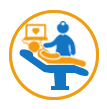PATIENT DETAILS
PATIENT DETAILS
Spinal cord or the backbone is a long, tubular structure composed of nervous tissues which originates from the base of the brain and extends till the lumbar region of the vertebral column. The brain and the spinal cord together make up for the Central Nervous System (CNS) that is responsible for integrating, coordinating and influencing a wide array of voluntary and involuntary activities throughout the body.
Anatomically, the human spinal cord is an intricate interlocking of 33 distinct bones that form the vertebral column. It functions by transmitting nerve signals across the body that helps in the smooth coordination of several motor and sensory actions.
Spinal cord injuries are sustained by external traumas, inflicted majorly through falls, accidents and strenuous physical activities. However, underlying orthopaedic conditions can also lead to spinal complications. It’s usually characterized by pain and immobility that can progressively develop into lack of sensation in the limbs depending on which part of the spinal cord is impacted and how severe is the damage incurred.
Depending on the location of the injury, spinal cord injuries can be classified into 4 broad heads.
- Cervical Spinal Cord Injuries: This segment comprises of spinal injuries sustained to the head and neck region above the shoulder.
- Thoracic Spinal Cord Injuries: Injuries to the spinal in and around the upper chest, mid-back and abdominal muscles come under this category.
- Lumbar Spinal Cord Injuries: Spinal injuries to the lower back are collectively studied under this segment.
- Sacral Spinal Cord Injuries: Injuries sustained below the lumbar region of the vertebral column come under sacral spinal cord injuries. The hips, back of thighs, buttocks and the pelvis region are mostly affected through this injury.
- Quadriplegia: It’s a kind of paralysis caused arising from an injury to the spinal cord that leads to loss of motor and sensory function in upper and lower limbs.
- Paraplegia: It’s a special case of quadriplegia that affects the lower limbs only.
In the event of a spinal cord injury, the patient must be rushed to the hospital at the earliest where critical care investigators can work to stabilize his/her breathing, immobilize the neck to prevent further damage to the spinal cord. The patient is also observed for his cardiovascular function, overall volume of excretion and possible blood clots sustained to the extremities during the trauma. IV venous medications may also be started to ease the discomfort.
Depending on the imaging reports, the patient may be scheduled for surgery in case of a spinal fracture, or prescribed medication and rehabilitation therapy to reinstate regular mobility.
Injuries to the spinal cord entail significant damage to the nerve fibres encased in it. And because nerve cells, unlike other body cells, do not regenerate, spinal cord injuries require a prolonged healing time.
After their primary treatment is over, patients are advised to undergo spinal rehabilitation therapy to reinstate their lost abilities. This is why the post-acute care phase of undergoing rehabilitation is instrumental in expediting the recovery of spinal cord injury patients.
Every spinal injury is different, and so is their process of recovery. Depending upon the patient’s clinical history after discharge from the hospital, their psychological stability and the willingness to re-learn basic motor skills, a customised rehabilitation plan is laid out in consultation with the doctors and therapists.
At ApoKOS Rehabilitation, Hyderabad, India’s first integrated rehabilitation hospital with advanced robotic technologies, we use the following rehabilitative approaches to nurse our patients back to their old selves.
- Physical Therapy
- Occupational Therapy
- Wheelchair Training
- Robotics Rehabilitation
- Counselling Therapy
- Bladder and Bowl Training
Physical Therapy
This is also known as rehab physiotherapy. It involves traditional rehabilitation methods along with cutting edge therapeutic approaches such as Manual Therapy, Geriatric Rehabilitation, Paediatric Rehabilitation, Cardio-pulmonary Rehabilitation, Robotics Technology, Neuromuscular Re-education Techniques, and Neuromuscular Pain Management with Electrotherapeutic Therapy. It comprises of a wide range of physical exercises that aims at regaining strength, balance and independence.
Occupational Therapy
This treatment aims at promoting health and independence through regular simple occupational activities. The patient is given some ordinary tasks to perform in order to gradually regain their ability to function independently. Occupational therapy follows a trail like this
- Individualised assessment of the current situation
- Intervention to ensure that the patients achieve the goals identified by the therapist
- Regular evaluation to keep track of the progress made by the patient
Wheelchair Training
This therapy is similar to occupational therapy; wheelchair training entails therapists teaching the patient how to independently operate a wheelchair with their hands. This helps the patient regain some independence in terms of supported movement. The occupational therapist trains the patients to be equipped with wheelchair transfers and mobility. Depending on each patient’s requirement the wheelchairs can be customised to make them independent community ambulation.
Robotic Technology
Systematic rehabilitation processes are supported by modern robotic technology that helps the patient regain balance and mobility.
- EKSO: This is a wearable suit that boosts strength, stamina, and mobility. EKSO is used to assist standing and gait training.
- ERIGO: This instrument is also used to assist standing, but for a more severely impaired and bed-ridden patient. ERIGO entails gradual ‘verticalization’ of the body with the support of passive robotic mobilisation.
- ARMEO POWER: ARMEO helps the patient gradually move their limbs and regain ability to function as independently as possible.
- BALANCE MASTER: This instrument helps the patient stand up and train to develop a balanced posture. With this, the patient can gradually re-learn to walk and move around.
Counselling Therapy
The advances in the treatment of spinal cord injuries have shifted from the emphasis of problems of survival to problems of psychological integration. Counselling therapies are now a vital part of the rehabilitation program. This therapy entails psychosocial skills training to teach the patients to cope with these issues on their own. The patients are evaluated based on their skills and strengths by a counsellor and based on their progress they are motivated to move forward.
Bowel and Bladder Training
After revaluation of the patients, they are trained to perform independent, clean and intermittent catheterization (CIC).
Comprehensive Neuro treatment
Throughout the patient’s stay at our facility, our trained nurses take care of the medical needs of the patient. They also ensure that the treatment continues as per plan by coordinating with the various team members and through regular feedback from the patient and family.
Our neurological rehabilitation program offers seven salient features

Comprehensive
We aim at physical, psychological, cognitive, cultural and social aspects of the patients’ personalities, their stage of recovery and their own and their family’s lifestyle.

Patient-centric
We customize our healthcare strategies according to the patients and their families for the patient is at the centre of our entire rehabilitation process

Integrated
We design and follow a multidisciplinary approach which includes expert and motivated care personnels experienced in working in a team structure.

Inclusive
We believe in the power of family support for the patient’s optimum rehabilitation so we encourage the family’s active participation and cooperation in the recovery process.

Empowering
We want our patients to be as independent as possible so we try to empower them and build their confidence by reducing increased dependence on mobility aids.

Continuous
We provide all possible human and material resources to tackle each and every problem of the patient as and when they arise to help them achieve the highest level of recovery and independence.

Committed
We know that a patient needing neurological rehabilitation might develop several new complications with age, so we offer out-patient rehabilitation to keep track of their life-long progress.


